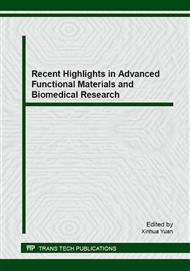[1]
M. M. Thackeray, A. Kock, M. H. Rossouw, D. Liles, R. Bittihn, D. Hoge, Spinel electrodes from the Li-Mn-O system for rechargeable lithium battery applications, J. Electrochem. Soc. 139(1992) 363-369.
DOI: 10.1149/1.2069222
Google Scholar
[2]
J. M. Tarascon, E. Wang, F. K. Shokoohi, W. R. Mckinnon, S. Colson, Spinel phase of LiMn2O4 as a cathode in secondary lithium cells, J. Electrochem. Soc. 138(1991) 2859-2864.
DOI: 10.1149/1.2085330
Google Scholar
[3]
A. Pasquier, A. Blyr, A. Cressent, C. Lenain, G. Amatucci, J. M. Tarascon, An update on the high temperature ageing mechanism in LiMn2O4-based Li-ion cells, J. Power Sources. 81-82(1999) 54-59.
DOI: 10.1016/s0378-7753(99)00136-6
Google Scholar
[4]
A. Yamada, K. Miura, K. Hinokuma, M. Tanaka, Synthesis and structural aspects of LiMn2O4±δ as a cathode for rechargeable lithium batteries, J. Electroche. Soc. 142(1995)2149-2156.
DOI: 10.1149/1.2044266
Google Scholar
[5]
H. S. Park, S. J. Hwang, J. H. Choy, Relationship between chemical bonding character and electrochemical performance in nickel-substituted lithium manganese oxides, J. Phys. Chem. B. 105(2002) 4860-4866.
DOI: 10.1021/jp010079+
Google Scholar
[6]
D. Kovacheva, H. Gadjov, K. Petrov, S. Mandal, M. G. Lazarraga, L. Pascual, J. M. Amarilla, R. M. Rojas, P . Herrero, J. M. Rojo, Synthesizing Nanocrystalline LiMn2O4 by a combustion toute, J. Mater. Chem. 12(2002) 1184-1188.
DOI: 10.1039/b107669h
Google Scholar
[7]
D. G. Wickham, W. J. Croft, Crystallographic and magnetic properties of several spinels containing trivalent JA-1044 manganese, J. Phys. Chem. Solids. 7(1958) 351-360.
DOI: 10.1016/0022-3697(58)90285-3
Google Scholar
[8]
G. Pistoia, D. Zane, Y. Zhang, Some aspects of LiMn2O4 electrochemistry in the 4 volt range, J. Electrochem. Soc. 142(1995) 2551-2557.
DOI: 10.1149/1.2050052
Google Scholar
[9]
M. Wakihara, Recent developments in lithium ion batteries, Mater. Sci. Eng. 31(20014) 109-134.
Google Scholar
[10]
Y. Xia,Y. Zhou, M. Yoshio, Capacity fading on cycling of 4 V Li/LiMn2O4 cells., J. Electrochem. Soc. 144(1997) 2593-2600.
DOI: 10.1149/1.1837870
Google Scholar
[11]
D. H. Jang, Y. J. Shin, S. M. Oh, Dissolution of spinel oxides and capacity losses in 4 V Li/LixMn2O4 cells, J. Electrochem. Soc. 143(1996) 2204-2210.
DOI: 10.1149/1.1836981
Google Scholar
[12]
M. M. Thackeray, S. H. Yang, A. J. Kahaian, K. D. Kepler, E. Skinner, J. T. Vaughey, S. A. Hackney, Structural fatigue in spinel electrodes in high voltage (4V) Li/LixMn2O4 cells, Electrochem. Solid. ST. 1(1998) 7-9.
DOI: 10.1016/s0378-7753(98)00223-7
Google Scholar
[13]
H. Huang, C. A. Vincent, P. G. Bruce, Correlating capacity loss of stoichiometric and nonstoichiometric lithium manganese oxide spinel electrodes with their structural integrity, J. Electrochem. Soc. 146(1999) 3649-3654.
DOI: 10.1149/1.1392528
Google Scholar
[14]
R. J. Gummow, A. De Kock, M. M. Thackeray, Improved capacity retention in rechargeable 4 V lithium/lithium-manganese oxide (spinel) cells, Solid State Ionics, 69(1994) 59-67.
DOI: 10.1016/0167-2738(94)90450-2
Google Scholar
[15]
P. Barboux, J. M. Tarascon, F. K. Shokoohi, The use of acetates as precursors for the low-temperature synthesis of LiMn2O4 and LiCoO2 intercalation compounds, J. Solid State Chem. 94(1991) 185-196.
DOI: 10.1016/0022-4596(91)90231-6
Google Scholar
[16]
M. M. Thackeray, P. J. Johnson, L. A. Picciotto, P. G. Bruce, J. B. Goodenough, Electrochemical extraction of lithium from LiMn2O4, Mater. Res. Bull. 19(1984) 179-187.
DOI: 10.1016/0025-5408(84)90088-6
Google Scholar
[17]
K. Kushida, K. Kuriyama, Observation of Li-atomic array in spinel-LiMn2O4 films spin-coated on Si substrates using an atomic force microscopy, Appl. Phys. Lett. 76(2000) 2238-2240.
DOI: 10.1063/1.126307
Google Scholar
[18]
S. H. Kang, J. B. Goodenough, L. K. Rabenberg, Effect of ball-milling on 3-V capacity of lithium-manganese oxospinel cathodes, Chem. Mater. 13(2001) 1758-1764.
DOI: 10.1021/cm000920g
Google Scholar
[19]
S. Choi, A. Manthiram, Synthesis and electrode properties of metastable Li2Mn4O9-δ spinel oxides, J. Electrochem. Soc. 147(2000) 1623-1629.
DOI: 10.1149/1.1393408
Google Scholar
[20]
P. Kalyani, N. Kalaiselvi, N. Muniyandi, A new solution combustion route to synthesize LiCoO2 and LiMn2O4, J. Power Sources, 111(2002) 232-238.
DOI: 10.1016/s0378-7753(02)00307-5
Google Scholar
[21]
K. Amine, H. Tukamoto, H. Yasuda, Y. Fujita., J. Electrochem. Soc. 143(1996) 1607-1613.
Google Scholar
[22]
Y. P. Fu, Y. H. Su, C. H. Lin, Comparison of microwave-induced combustion and solid-state reaction for synthesis of LiMn2-xCrxO4 powders and their electrochemical properties, Solid State Ionics, 166(2004) 137-146.
DOI: 10.1016/j.ssi.2003.09.018
Google Scholar
[23]
H. Benlin, Z. Wenjia, L. Yanyu, B. Shujuan, L. Hulin, Synthesis and electrochemical properties of chemically substituted LiMn2O4 prepared by a solution-based gel method, J. Colloid Interface Sci. 300(2006) 633-639.
DOI: 10.1016/j.jcis.2006.04.002
Google Scholar
[24]
S. B. Park, H. C. Shin, W. G. Lee, W. II. Cho, H. Jang, Improvement of capacity fading resistance of LiMn2O4 by amphoteric oxides, J. Power Sources. 180(2008) 597-601.
DOI: 10.1016/j.jpowsour.2008.01.051
Google Scholar
[25]
A. D. Robertson, S. H. Lu, W. F. Averill, W. F. Howard Jr, M3+-modified LiMn2O4 spinel intercalation cathodes. I. Admetal effects on morphology and electrochemical performance, J. Electrochem. Soc. 144(1997) 3500-3505.
DOI: 10.1149/1.1838040
Google Scholar
[26]
G. H. Li, H. Ikuta, T. Uchida, M. J. Wakihara, The spinel phases LiMyMn2-yO4 (M=Co, Cr, Ni) as the cathode for rechargeable lithium batteries, J. Electrochem. Soc. 143(1996) 178-182.
DOI: 10.1002/chin.199619011
Google Scholar
[27]
K. Oikawa, T. Kamiyama, F. Izumi, D. Nakazato, H. Ikuta, M. Wakihara, Neutron and X-ray powder diffraction studies of LiMn2-yCryO4, J. Solid State Chem. 146(1999) 322-328.
DOI: 10.1006/jssc.1999.8351
Google Scholar
[28]
Y. P. Wu, E. Rahm, R. Holze, Effects of heteroatoms on electrochemical performance of electrode materials for lithium ion batteries, Electrochimica Acta. 47(2002) 3491-3507.
DOI: 10.1016/s0013-4686(02)00317-1
Google Scholar


